If you find fossils like these, perhaps the pictures and descriptions below will help you in some way to either identify your fossils or perhaps give you some good information about them.
I'm really blessed to live along the Mid-Atlantic Coast of the U.S.A. because of the rich fossil deposits along our tidal rivers, bays, and the Atlantic coastline. I will cover several species in this post, but anything I don't get to here will be covered at a later date in future posts.
(Above) Pictured left to right, I think it's a small toothed whale, but could be a large porpoise tooth, both teeth to the right of that is Carcharocles chubutensis (ancestor to the famous megalodon), and the one on the right is Carcharocles megalodon (the "shamer" half tooth is almost 4 1/2 inches long). These sharks are fossils of extinct giant white sharks, or megatooth sharks.
Many experts believe that this lineage died out about two million years ago at the end of the Pliocene epoch. Many theories exist as to why they became extinct, but we may never know. Others believe that this is the ancestor to the modern great white shark, Carcharodon carcharias. The evidence in the fossil record seems to point to a different ancestor to our modern great white, which may have been an extinct giant mako shark, Cosmopolitodus hastalis. The teeth are remarkably similar in size, shape, and jaw position and the only difference appears to be that the extinct mako lacks the serrations of the modern great white shark.
You can follow the comparisons here: http://www.elasmo.com/genera/slides/gw_evo/gw_intro.html. Make sure that if you follow that link to use the drop down menu at the top right to view each part of the article. It's really fascinating to me. C. chubutensis grew to over 40 feet long sporting teeth over four inches long, while many believe that C. megalodon grew to 60 feet or more with teeth exceeding a whopping seven inches long!!!! By the way, the website http://www.elasmo.com/ is a great website that can assist you in identifying your finds.
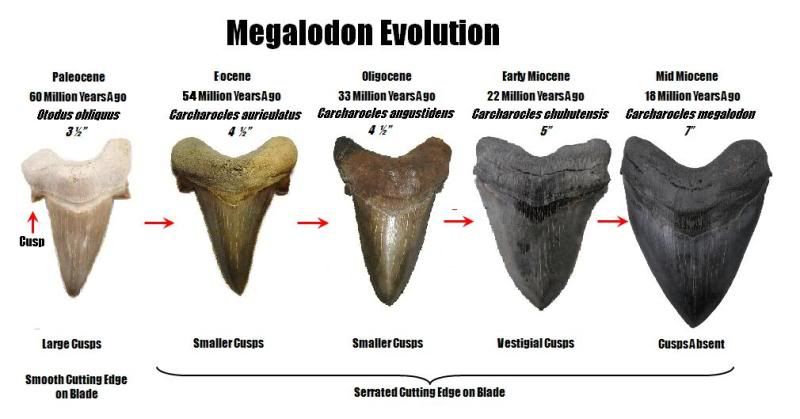 |
The chart above suggests the possible evolution of the massive megatooth extinct great white shark, Carcharocles megalodon. There is one tooth not pictured that may have given rise to Otodus obliquus on the left of the chart called Cretalamna appendiculata from the Cretaceous and lived into the Paleocene.
(link here: http://www.elasmo.com/genera/cretaceous/cretalamna.html) You'll notice that the older sharks, like Otodus obliquus, lack serrations, aren't as pronounced, or only partially cover the blade, and through evolution become more pronounced and completely cover the blade. Likewise, the older teeth have large cusplets (basically, small blades or points jutting out of the root or blade). As these sharks evolved, you'll notice the cusplet sizes decreased over time until non-existant in megalodon. And finally, the blades become more robust and massive, and the teeth increase in size overall size (as the size of these sharks increased).
|
The picture right below is "in situ" (latin for in position), in this case, a ground shot photo of the posterior meg tooth that I found in the previous picture.
 |
| Can you spot the tooth in this in-situ photograph? |
To find these teeth, you not only need to recognize their shapes, how they glisten when wet or shine in the sun, sometimes their color, but especially when they are partially exposed. You need to recognize a partial root, or part of a blade sticking out leaving a sharp even edge unlike the shells around it. As you see in the picture at left, there is a lot of shell material on the beach. I'd venture to say that about ninety five percent of the shells that you'll find along the Calvert Formation are fossil material.
How do the teeth and other fossils wind up on the beach? Millions and millions of years ago, much of the Mid-Atlantic coastal plain of today was covered by the ocean. As animals died they settled on the sea floor and became buried by silt or sand. Those dead animals became fossilized eventually. But, most of the shark teeth that you find were simply teeth that sharks lost as they fed. Sharks shed teeth as they feed at the rate of five to ten thousand per year, per shark, depending on the species. As prehistoric sharks lost their teeth, they settles into the silt on the sea floor and became buried. Layer upon layer of silt and animal remains settled on the sea floor for millions and millions of years, eventually becoming clay and rock. All the while, the fossilization of the animal remains occurred.
After the oceans receded, what was once ocean floor, became exposed above sea level. In our region, these exposed fossil deposits were eroded by water and wind eventually forming cliffs showing layers of the clay material. Over time, as the cliffs eroded, chunks and boulders of clay crashed to the beach below. Those boulders contained the fossils. Waves and tidal currents stripped the clay material, and the boulders eroded quickly into small pebbles (like in the picture), or just sand and silt, and left the fossils strewn across the beach. Waves and currents continually cover and expose the fossils that we're lucky enough to find.
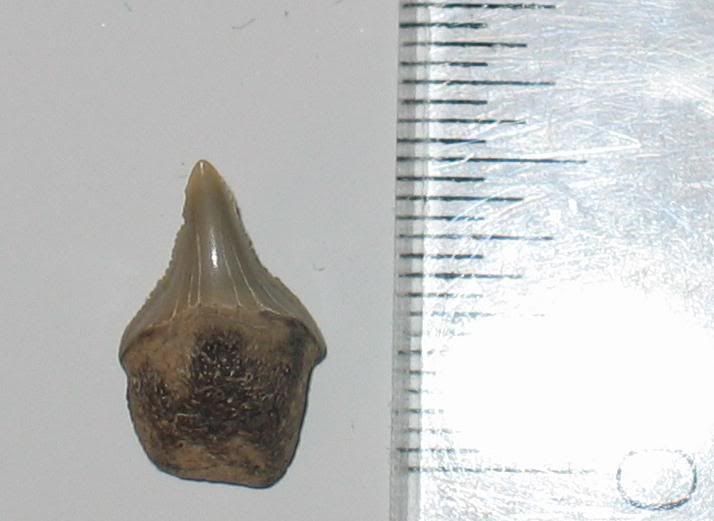
The tooth above is currently unidentified. I found it in the Calvert Formation. It's serrated and uniform, and several local amateur paleontologists and collectors believe that it could be a great white shark, Carcharodon carcharias. But, modern great white teeth are so rare here that I have yet to hear of anyone finding one. So, more than likely, it's probably a posterior juvenile tooth of Carcharocles megalodon. If anyone knows for sure, I'd appreciate a comment. At any rate, even though it 's quite small, it's one of my coolest teeth from the Calvert Formation. The root is robust, the blade serrated, and there are no notches. Edit: I've since had the tooth identified as a symphyseal megalodon tooth, probably from a smaller adult shark.
The next tooth pictured in the above two photos, is Hemipristis serra, commonly known as the snaggletooth shark. This is one of my favorite species of shark teeth. It became extinct after the Miocene about 18 million years ago. Teeth from this shark sometimes exceed 1 1/4 inches long suggesting that this shark grew to about 15 to 20 feet perhaps. This must have been quite an opportunistic feeder because it has such a varied array of teeth in the jaw (known as the animals dentition).
The upper teeth, like the two pictured above, have nasty huge serrations, like a steak knife and are extremely sharp. The first picture shows an upper anterior (front) tooth. The second pic, is an upper lateral (toward the side of the jaw) tooth. These cool looking teeth are designed for cutting. It's a fairly robust tooth as well with a root as strong as the modern tiger shark.
The lower anterior (front) teeth, pictured above, resemble those of sand tiger sharks, although they all have serrated edges, some of serrations can be completely worn away and can confuse collectors who may misidentify them as a sand tiger shark. The lower teeth are needle like (although a bit more robust) and somewhat hooked, which are perfect for grasping and holding prey while the upper teeth do the dirty work. I imagine that this shark was a formidable predator in it's day.
There is a modern day relative, Hemipristis elongata that lives off the coast of Africa. The modern day shark only grows to about eight feet long, yet has a similar dentition, pictured on Elasmo.com here: http://www.elasmo.com/selachin/slides/dent/pics/h_elongata-dent.jpg.
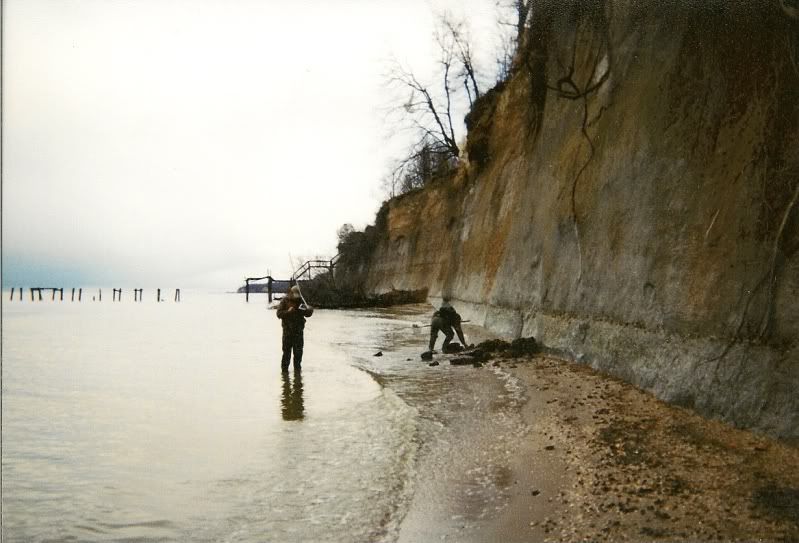 |
| My brother and I were collecting along this beach years ago. Not only did we find fossils, but, we enjoyed the peace and solitude, as our minds drifted back to the Miocene. |
There are many techniques that people employ to find fossils, and I'll save that for a future blog post, but sometimes nature will do the work for you. Each wave can expose something new to find. Please note that it's illegal to dig into the cliffs. Anything that you find here must come from the beach deposits.
Now, before we move on, let me clarify that the megalodon and chubutensis teeth above are not very common. I may only find a few each year. The teeth pictured at above are more of a typical mix of what you'd find on an average trip. The top left tooth is a sand tiger shark tooth.
Notice the long, slender, needle like shape perfect for grasping prey, especially fish. The lower anterior teeth of Hemipristis serra resemble these in shape. Directly below that tooth is a cow shark tooth, Notorynchus primigenius, which has many cusplets. These shark teeth also are some of my favorite finds and are very cool. To the right of those are mako teeth, more Hemipristis serra teeth, and below those are two species of extinct tiger sharks, and below that are lemon shark teeth and various requiem shark teeth that are extinct relatives of todays bull sharks.
Anyway, you get a feel of how many shark teeth and different species that are likely to be found when conditions are right. I'll get into more detail later about some of the species in that picture.
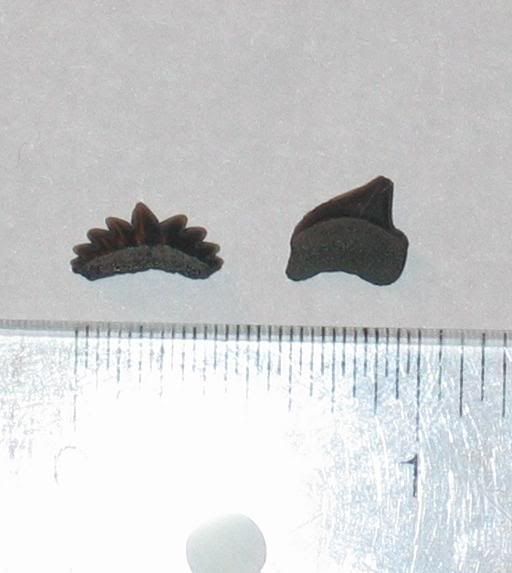
The above picture shows two very special finds. The left tooth is cow shark, or sevengill shark, Notorynchus primigenius, a tooth that is fairly rare because of it's position in the jaw. It's known as a symphyseal tooth, which is a fancy scientific word describing the center of the jaw. This symphyseal tooth is from the cow sharks lower jaw. As mentioned above, cow shark teeth really get me fired up when I find them. They are not very common and just are very cool indeed.
The tooth on the right is from a crow shark, Squalicorax kaupi, which became extinct long before the sharks of the Miocene. It was a special find simply because it's from another time period, the Cretaceous, or the time of the dinosaurs, probably about a hundred million years old or so. So what's so special about that? Well, that formation is not near the Calvert Formation. It's normally found about 50 miles away on the other side of the bay. So, how did it get there? We can only speculate. Perhaps it was deposited during a flood millions of years ago after the Cretaceous period when the oceans receded. Perhaps a collector that had been exploring Cretaceous deposits had one stuck in a sifter and accidentally dropped it. More than likely, though, it was "reworked", which means that some other force of nature, perhaps and animal, like a shrimp, or crab, created a burrow and pushed the tooth from a deeper layer up into the Calvert Formation. This could have even occurred from modern day animals burrowing, like ground hogs. I've found two of these speces at this location.
Back to cow sharks. In the picture above, there is a tooth from the upper anterior of a cow shark jaw. It's the right most tooth in the picture. You'll notice that it has less cusplets than the symphyseal tooth shown earlier. In case you're wondering, the tooth on the left is a snaggletooth shark, and the center tooth is a C. chubutensis, or extinct great white.
The main cusp was damaged on the one in the in situ photo. But, on a different trip, I found a real nice one, above. It was complete and perfect. Notice the serrations ahead of the main cusp on the right edge of the blade. The root is thin and fragile, but deep. Cow shark teeth are not the primary goal of the collector. In fact, most everyone leaves their house for a hunt hoping to find the elusive megalodon. If you don't find a "meg" on your trip but come home with a cow shark tooth, then that's a real nice consolation prize if you ask me. Always remember though, that no collection is complete unless you have representative specimens of each species of shark. The tooth on the right is a porpoise tooth.
A riker mount full of teeth like this makes for a very impressive display, one that would cause jealousy among many fossil hunters around the world.
The next tooth that I'll show you is a mako shark Isurus desori (pictured above). There are three types of extinct mako sharks that you can find in the Calvert Formation. Isurus desori, or shortfin mako, and Isurus retroflexus, or longfin mako, are very similar to the shortfin and longfin makos of today. The only difference is probably that the size of the mako teeth from the Miocene are slightly larger than their modern relatives.
Cosmopolitodus hastalis, is the third species found in the Calvert Formation. Many palaeontologists think that C. hastalis was the direct ancestor to our modern day great white shark. I'll have pictures of those teeth in future fossil updates.
The right most tooth in the picture above is from a Bigeye Thresher shark Alopias superciliosus. These teeth are not common at the cliffs. The teeth are always less than an inch long, but have robust roots and blades, and are unserrated. There are two species of thresher sharks that lived around here millions of years ago. Thresher sharks, it's believed, use the upper lobe of the tail, which is extremely long, to herd baitfish in huge baitballs, and the sharks gorge themselves while feeding on the bait ball. Some people think that they can actually use their tails to maim prey, like fish.
There are several types of commonly found teeth, but I'll post about those at a later date. Hopefully, for a while, this will be enough for you to absorb!
While you're waiting for the next update, check out these great fossil websites and forums: http://www.thefossilforum.com/ and http://www.blackriverfossils.org/.
There's a lot of information on those sites in addition some knowledgeable and friendly people.


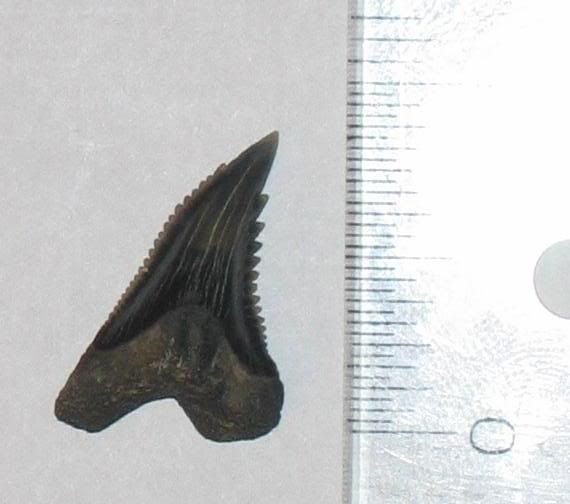
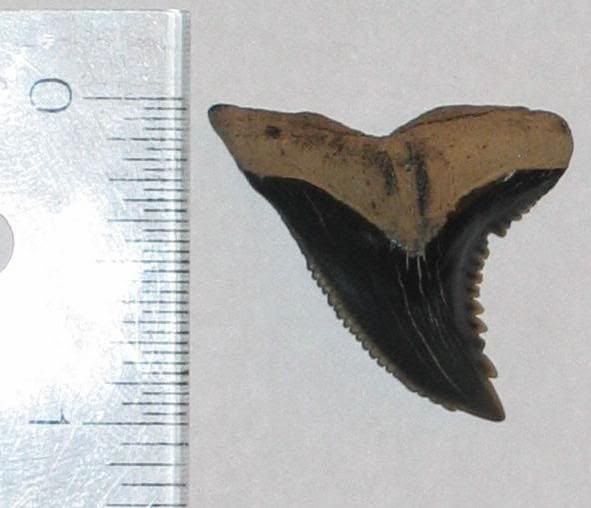

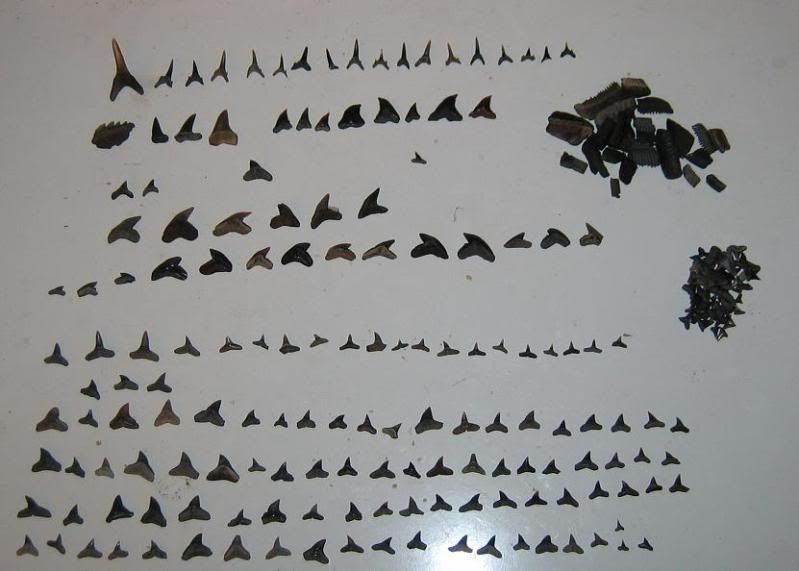
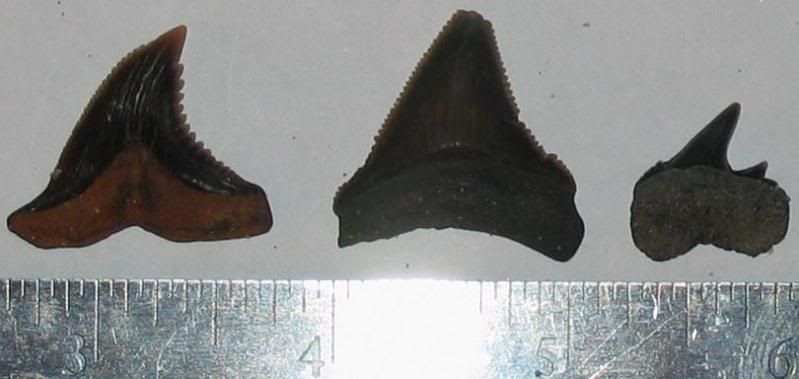


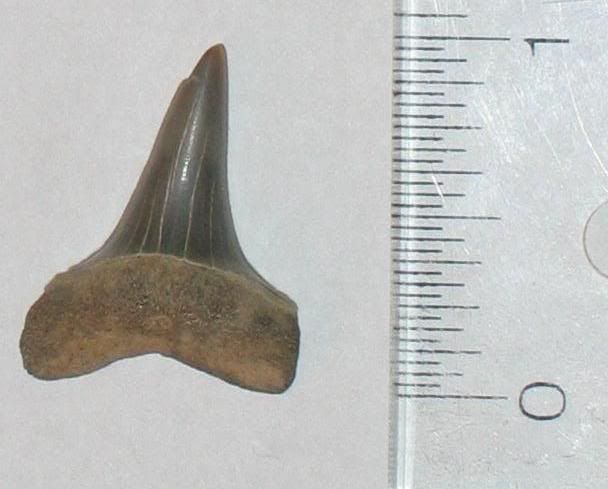
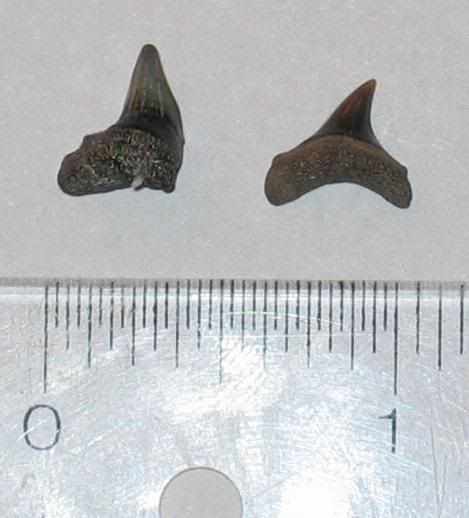
Hey man after lookong at the posterior unknown tooth is a posterior lower megalodon. The uppers are curved so my guess posterior lower
ReplyDeleteThanks Bmore!!!! I appreciate the feedback and confirmation!
ReplyDeleteHey "Fat Boy" :), My guess is that the unknown tooth in question is a parasymphyseal to possibly a Chubutensis. I have found this tooth position for Auriculatus and Angustidens it looked very similar. Sweet find! (Rob Campbell aka Haizahnjager)
ReplyDeleteThank you Rob for the ID! Much appreciated! I will label it as such in my collection display.
ReplyDeleteI think that the shape of this tooth is too narrow for a posterior.
ReplyDeletehttp://www.thefossilforum.com/index.php?/topic/39700-need-help-for-a-strange-megalodon/
I assume that you're a TFF member hence the link. Thanks for the info to the thread, I hadn't read that one. I think that my tooth looks very much the same as the one Marco in the thread ID'd.
ReplyDelete